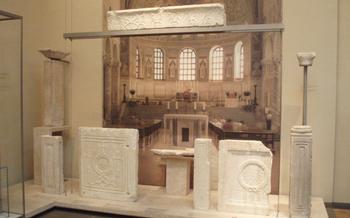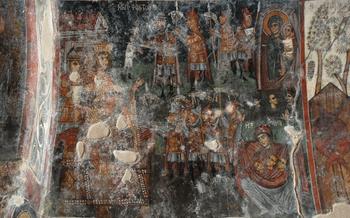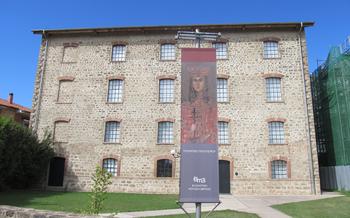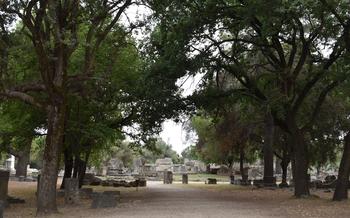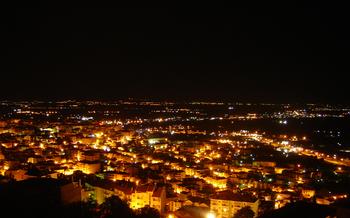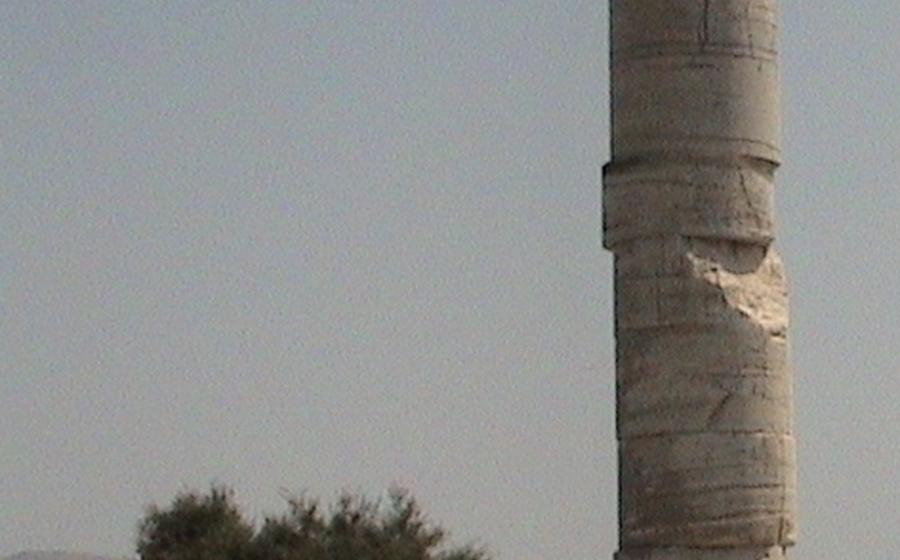
Samos Byzantine Museum
- Samos Byzantine Museum: A Journey Through History and Art
- Exploring the Museum's Collection: Unveiling Hidden Treasures
- Icons: Windows to Divine Presence
- Ceramics and Sculptures: Shaping History in Clay and Stone
- Mosaics: Capturing Light and Faith in Art
- Textiles: Embroidered Devotions and Everyday Elegance
- Coins: Glimmers of Byzantine Economy and Power
- Interactive Exhibits: Engaging Visitors with History
- Temporary Exhibitions: Unfolding New Narratives
- Guided Tours: Unlocking Hidden Stories
- Museum Shop: Souvenirs and Treasures to Take Home
- Accessibility: Ensuring a Welcoming Experience for All
- Photography and Social Media: Sharing the Byzantine Legacy
- Insider Tip: Discovering Hidden Gems
Samos Byzantine Museum: A Journey Through History and Art
Nestled in the heart of the picturesque town of Vathy, the capital of the enchanting island of Samos, the Samos Byzantine Museum stands as a testament to the rich cultural heritage of the Byzantine Empire. This captivating museum invites visitors to embark on a journey through time, where they can delve into the depths of Byzantine art, history, and religious devotion.
The museum boasts a remarkable collection of artifacts that tell the story of Samos' Byzantine past, from the 5th to the 15th centuries AD. From exquisite icons and illuminated manuscripts to intricate ceramics and sculptures, each piece narrates a chapter of the island's Byzantine legacy.
The museum's establishment in 1987 marked a significant milestone in the preservation and promotion of Byzantine culture on Samos. Its collection has been meticulously curated over the years, drawing from various sources, including local churches, monasteries, and private donations. Today, the Samos Byzantine Museum stands as a beacon of knowledge and inspiration, attracting visitors from around the world who seek to immerse themselves in the splendor of Byzantine artistry and explore the island's deep historical roots.
Exploring the Museum's Collection: Unveiling Hidden Treasures
The Samos Byzantine Museum houses a remarkable collection of artifacts that provide a glimpse into the rich artistic and cultural heritage of the Byzantine Empire. Among the highlights are exquisite icons, intricate manuscripts, ornate ceramics, sculptures, mosaics, and textiles. Each piece offers a unique perspective on Byzantine history, religious beliefs, and artistic traditions.
The icons in the collection are particularly notable for their vivid colors, expressive faces, and intricate details. They depict a variety of religious figures, including Christ, the Virgin Mary, and various saints. These icons were not merely decorative objects but were considered sacred and used for devotional purposes in both churches and private homes.
The manuscripts in the museum's collection are equally impressive. They range from religious texts and historical chronicles to scientific treatises and literary works. These manuscripts are not only valuable for their content but also for their exquisite calligraphy and illuminations. They offer a glimpse into the intellectual and literary achievements of the Byzantine Empire.
The ceramics and sculptures in the collection provide insights into the everyday life and artistic expression of the Byzantine people. The ceramics include both functional items, such as plates and bowls, and decorative pieces, such as vases and figurines. The sculptures range from small statuettes to large-scale reliefs, and they depict a variety of subjects, including religious figures, mythological creatures, and historical events.
The mosaics in the museum's collection are particularly striking for their use of vibrant colors and intricate patterns. They were often used to decorate churches and other religious buildings, and they depicted a variety of scenes from the Bible and the lives of the saints. The mosaics in the Samos Byzantine Museum are some of the finest examples of this art form.
The textiles in the collection offer a glimpse into the Byzantine Empire's rich tradition of weaving and embroidery. They range from simple, functional textiles to elaborate, richly decorated pieces. Many of the textiles in the collection were used for religious purposes, such as vestments and altar cloths. Others were used in everyday life, such as clothing, tapestries, and carpets.
Icons: Windows to Divine Presence
In Byzantine culture, icons held a profound significance, serving as sacred objects of veneration and devotion. These painted images depicted religious figures, saints, and biblical scenes, acting as windows to the divine realm. The Byzantine Empire embraced iconography as a powerful tool for expressing religious beliefs and transmitting spiritual messages.
The Samos Byzantine Museum houses a remarkable collection of icons, each a unique masterpiece of Byzantine art. These icons showcase the exceptional skill and artistry of Byzantine iconographers, who meticulously crafted these sacred images using egg tempera on wood panels. The vibrant colors, intricate details, and expressive faces of the icons captivate visitors, inviting them to contemplate the divine and connect with the spiritual realm.
Among the notable iconographers whose works are featured in the museum are Manuel Panselinos, Theophanes the Cretan, and El Greco. These masters of Byzantine iconography created iconic images that continue to inspire and awe viewers with their technical prowess and spiritual depth. Through their icons, these artists sought to convey the essence of the divine, capturing the emotions, expressions, and stories of religious figures in a way that resonated deeply with the Byzantine faithful.
Ceramics and Sculptures: Shaping History in Clay and Stone
Byzantine ceramics and sculptures played a significant role in both the artistic and everyday life of the Byzantine Empire. The Samos Byzantine Museum houses a remarkable collection of these artifacts, offering visitors a glimpse into the craftsmanship and creativity of the period.
Among the notable ceramic pieces are exquisite plates, bowls, and vases adorned with intricate patterns and vibrant colors. These ceramics served both functional and decorative purposes, showcasing the Byzantines' mastery of pottery and glazing techniques.
The museum also displays a variety of sculptures, ranging from small statuettes to larger-than-life statues. These sculptures were often used to decorate churches, public buildings, and private homes. They depicted religious figures, mythological scenes, and historical events, providing insights into Byzantine artistic styles and iconography.
One of the highlights of the collection is a beautifully preserved marble statue of a young woman, known as the "Lady of Samos." This life-size statue is believed to date back to the 6th century AD and is a testament to the skill and artistry of Byzantine sculptors.
Through these ceramics and sculptures, the Samos Byzantine Museum offers visitors a tangible connection to the daily lives and artistic traditions of the Byzantine Empire, shedding light on the empire's cultural and historical significance.
Mosaics: Capturing Light and Faith in Art
Byzantine mosaics stand as testaments to the empire's artistic prowess and deep-rooted faith. These intricate works of art, composed of small, colored tiles, adorned religious and secular spaces alike, radiating an ethereal luminosity that enchants the senses. The artists who crafted these mosaics employed a technique called opus tessellatum, meticulously arranging tesserae, or small pieces of stone, glass, or ceramic, to create vibrant and enduring images.
The themes depicted in Byzantine mosaics were predominantly religious, drawing inspiration from the Bible and the lives of saints. Churches and monasteries were adorned with scenes of biblical narratives, such as the Annunciation, the Crucifixion, and the Resurrection, which served as visual aids for worshippers and pilgrims. In secular contexts, mosaics often depicted scenes of imperial triumphs, hunting expeditions, and everyday life, offering a glimpse into the social and cultural tapestry of the Byzantine Empire.
One of the most captivating examples of Byzantine mosaic art in the Samos Byzantine Museum is the stunning depiction of the Virgin Mary and Child. The Virgin is portrayed with a serene expression, her eyes gazing gently downward at the infant Jesus, who nestles in her arms. The tesserae used to create this mosaic shimmer and sparkle, capturing the light and imbuing the image with a sense of divine radiance.
Beyond religious iconography, the museum's collection also showcases mosaics that adorned secular buildings, such as palaces and villas. These mosaics often depicted scenes of nature, mythological tales, and historical events, providing a glimpse into the Byzantine Empire's fascination with the classical world.
As you wander through the museum's galleries, take the time to marvel at the intricate details and vibrant colors of the Byzantine mosaics. Let these exquisite works of art transport you back in time, allowing you to glimpse the splendor and devotion that defined this remarkable civilization.
Textiles: Embroidered Devotions and Everyday Elegance
Textiles played a significant role in Byzantine culture, serving both religious and practical purposes. Elaborately embroidered textiles were used in religious ceremonies, adorning churches and priestly vestments. These textiles often depicted intricate religious scenes and symbols, reflecting the deep devotion and craftsmanship of Byzantine artisans.
In the Samos Byzantine Museum, visitors can admire a stunning collection of Byzantine textiles that showcase the skill and artistry of these weavers. From finely embroidered liturgical garments to opulent tapestries, each piece tells a story about the Byzantine era.
One notable exhibit is a beautifully preserved silk textile fragment from the 12th or 13th century. It features a vibrant depiction of the Virgin Mary surrounded by angels, with intricate gold thread embroidery that shimmers in the light. The colors and details of the embroidery are remarkably well-preserved, offering a glimpse into the artistry of Byzantine textile makers.
Another highlight is a collection of everyday textiles, such as tunics, scarves, and cushion covers. These textiles provide insights into the daily lives of Byzantines and showcase the diverse techniques and materials used in textile production. From simple wool garments to luxurious silk fabrics, these textiles offer a glimpse into the Byzantine world beyond the sacred realm.
Exploring the textile collection at the Samos Byzantine Museum is like stepping back in time and witnessing the vibrant artistry and craftsmanship of the Byzantine era. These textiles not only tell stories of faith and devotion but also offer a glimpse into the everyday lives and cultural traditions of the Byzantine people.
Coins: Glimmers of Byzantine Economy and Power
Coins played a crucial role in the Byzantine economy, serving as a medium of exchange, a store of value, and a symbol of imperial authority. The Samos Byzantine Museum houses an impressive collection of Byzantine coins, offering visitors a glimpse into the monetary system and economic practices of the Byzantine Empire.
The museum's coin collection spans various periods of Byzantine history, from the early centuries of the empire to its final days. Visitors can admire gold, silver, and bronze coins, each with its unique design and iconography. Some coins feature the effigies of Byzantine emperors and empresses, while others depict religious figures, military victories, or important events.
Beyond their monetary value, Byzantine coins also served as potent symbols of imperial power and legitimacy. The coins' designs and inscriptions often conveyed political messages, commemorated significant achievements, or promoted the emperor's authority. By studying these coins, visitors can gain insights into the political and ideological landscape of the Byzantine Empire.
The Samos Byzantine Museum's coin collection is a treasure trove for numismatists, historians, and anyone interested in Byzantine culture. These tiny metal discs offer a tangible connection to the economic and political realities of a long-vanished empire.
Interactive Exhibits: Engaging Visitors with History
The Samos Byzantine Museum enhances the visitor experience through a range of interactive exhibits and multimedia displays. These innovative tools bring Byzantine history and culture to life, allowing visitors to engage with and understand the past in a more immersive and interactive way.
Touchscreens and interactive panels provide in-depth information about the exhibits, allowing visitors to explore the lives and works of Byzantine artists, scholars, and rulers. Virtual reality experiences transport visitors back in time, immersing them in the sights, sounds, and atmosphere of Byzantine cities and monasteries.
The museum also offers educational programs and workshops for visitors of all ages. These programs provide hands-on experiences, such as creating Byzantine-inspired mosaics or learning traditional Byzantine crafts, deepening visitors' understanding of Byzantine art and culture. Through these interactive exhibits and educational programs, the Samos Byzantine Museum fosters a dynamic and engaging learning environment that encourages visitors to explore the rich history and legacy of the Byzantine Empire.
Temporary Exhibitions: Unfolding New Narratives
The Samos Byzantine Museum is dedicated to presenting not only its permanent collection but also a variety of temporary exhibitions that delve into specific aspects of Byzantine history and culture. These exhibitions offer an opportunity for visitors to explore new themes and perspectives, providing a dynamic and ever-changing experience.
Past exhibitions have showcased topics such as "The Art of Byzantine Jewelry," "Samos in the Early Christian Era," and "Byzantine Maritime Trade." These exhibitions have featured rare artifacts, interactive displays, and multimedia presentations, immersing visitors in the rich tapestry of Byzantine life.
Keep an eye out for upcoming exhibitions at the Samos Byzantine Museum. These temporary displays offer a chance to discover new facets of Byzantine history and culture, and to gain a deeper understanding of this fascinating era.
Guided Tours: Unlocking Hidden Stories
Enhance your visit to the Samos Byzantine Museum by joining a guided tour led by knowledgeable and passionate historians. These tours offer an in-depth exploration of the museum's collection, providing visitors with a deeper understanding of the exhibits and their historical context.
Expert guides will take you on a journey through time, shedding light on the significance of each artifact and its role in Byzantine history and culture. They will share fascinating stories and anecdotes, bringing the past to life and helping you connect with the people and events that shaped this era.
The museum offers a variety of guided tours tailored to different interests and levels of knowledge. Whether you're a history buff seeking deeper insights or a first-time visitor looking for an introduction to Byzantine art and culture, there's a tour that's perfect for you.
Group tours are available for pre-booked groups of 10 or more people, providing a tailored experience for families, school groups, and organized tours. These tours can be customized to meet specific interests and educational needs.
To make the most of your visit, be sure to book your guided tour in advance, especially during peak season. Check the museum's website or contact them directly for tour schedules, availability, and pricing information.
Museum Shop: Souvenirs and Treasures to Take Home
The Samos Byzantine Museum offers a well-curated museum shop where visitors can find a range of souvenirs and treasures to take home. These items serve as tangible reminders of the museum's rich collection and the vibrant history of the Byzantine era.
From beautifully illustrated books on Byzantine art and history to replicas of iconic artifacts, the museum shop caters to a wide range of interests. Visitors can choose from a selection of postcards, magnets, and other small keepsakes featuring images of the museum's most notable exhibits.
For those seeking more substantial souvenirs, the museum shop offers a variety of high-quality replicas of Byzantine jewelry, pottery, and religious objects. These replicas are meticulously crafted using traditional techniques and materials, ensuring their authenticity and beauty.
In addition, the museum shop features a collection of unique and exclusive items that cannot be found anywhere else. These items, often inspired by the museum's collection, make for truly special souvenirs or gifts for loved ones.
Whether you're a history buff, an art enthusiast, or simply someone looking for a meaningful memento of your visit, the Samos Byzantine Museum shop has something for everyone. By purchasing souvenirs from the museum, visitors not only take home a piece of Byzantine history but also support the museum's ongoing efforts to preserve and promote this rich cultural heritage.
Accessibility: Ensuring a Welcoming Experience for All
The Samos Byzantine Museum is committed to providing an accessible and inclusive environment for all visitors, regardless of their abilities or disabilities. The museum features a variety of accessibility features to ensure that everyone can enjoy and learn from its exhibits.
Wheelchair ramps and elevators are available throughout the museum, allowing visitors with mobility impairments to navigate the building easily. The museum also provides wheelchairs for visitors who may need them, upon request.
The museum's exhibits are designed with accessibility in mind. Braille labels and audio guides are available for visually impaired visitors, allowing them to learn about the exhibits in a tactile or auditory manner.
Visitors with hearing impairments can take advantage of the museum's sign language interpreters, who can provide guided tours and assist with communication throughout the museum.
The museum staff is trained to be welcoming and accommodating to visitors with disabilities. They are happy to provide assistance and answer any questions that visitors may have.
By implementing these accessibility features and services, the Samos Byzantine Museum strives to create a welcoming and inclusive environment where all visitors can enjoy and learn from its rich collection of Byzantine art and artifacts.
Photography and Social Media: Sharing the Byzantine Legacy
The Samos Byzantine Museum encourages visitors to capture their experiences and share their photos on social media. While doing so, it's essential to respect copyright laws and maintain the integrity of the exhibits. Tagging the museum (@samosbyzantinemuseum) allows visitors to be featured on the museum's social media platforms and contribute to the broader community of Byzantine art enthusiasts.
Sharing experiences and photos on social media not only helps spread awareness about the museum and its collection but also creates a sense of community among visitors who share a passion for Byzantine history and culture. Visitors are encouraged to use relevant hashtags, such as #SamosByzantineMuseum, #ByzantineArt, and #Greece, to connect with others who share their interests.
In addition, the museum's social media presence provides a platform for sharing updates on upcoming exhibitions, educational programs, and special events. Visitors can stay informed about the latest happenings at the museum and plan their visits accordingly.
Insider Tip: Discovering Hidden Gems
As you wander through the labyrinthine halls of the Samos Byzantine Museum, keep an eye out for a hidden gem often overlooked by visitors. Tucked away in a secluded corner, you'll find a small, unassuming display that holds a captivating secret. Within this humble exhibit lies a collection of intricately carved Byzantine seals, each a testament to the artistry and craftsmanship of the era. These tiny masterpieces, often used to authenticate documents and signify authority, offer a glimpse into the intricate details of Byzantine life. Take a moment to examine these exquisite seals, marveling at the skill and precision with which they were created. They serve as a reminder that even the smallest artifacts can hold profound historical significance, waiting to be discovered by curious and discerning visitors like yourself.
